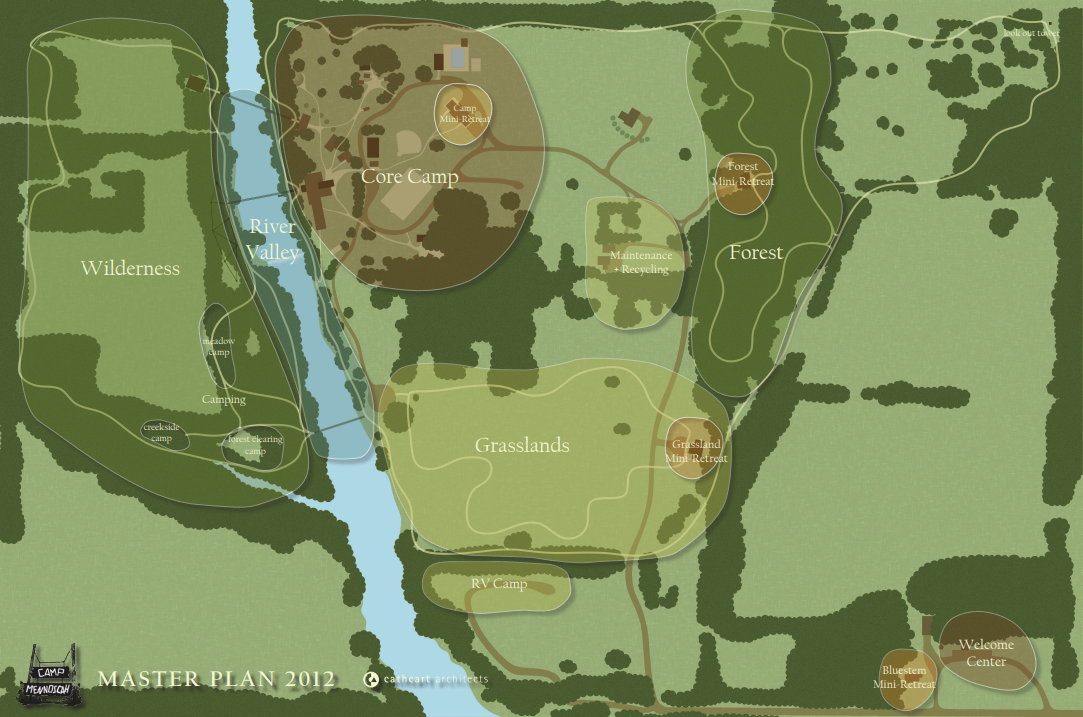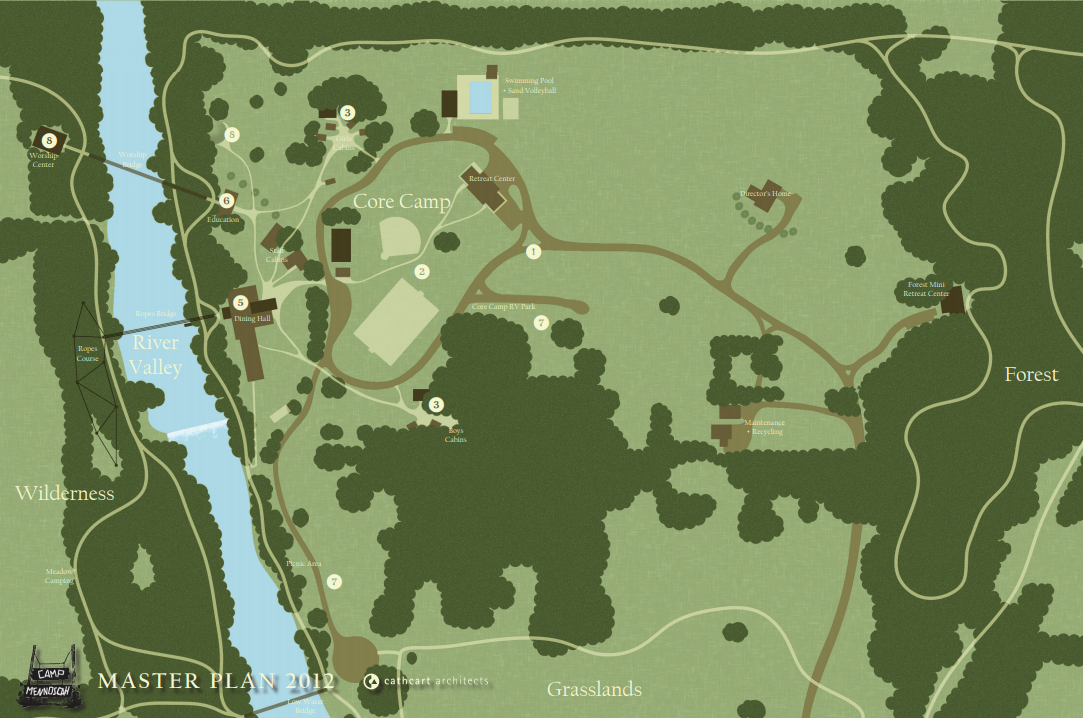Master Plan
As Camp Mennoscah looks to the future, we realize that this cannot be accomplished without some sort of vision. To that end, the Camp Association has sought out the aid of an architectural firm, Cathcart Architects, to aid in the creation of a master plan. Nothing that you see here is "set in stone," but is merely a starting place. It is a forum to stimulate ideas and conversation. If you have a comment or suggestion for our master plan, please send your feedback to office@campmennoscah.org. We welcome and appreciate your involvement in our projects!
Overall Camp Property Master Plan

With the recent acquisition of the Bluestem farm at the southeast corner of the campus property, the barnyard serves as the main entry point for purposes of orienting guests and welcoming summer campers. A new loop road allows for an active check-in point for summer activities, but a more passive information center and campus map offer a point of reference for Camp visitors. A new gateway marks the arrival at Camp Mennoscah, and additional signage presents wayfinding across the 240 acre campus. (work in this area could include: gateway, barn repair + grading or roadwork)
Although Camp Mennoscah features a retreat center as part of the core of the camp, the Bluestem house is currently being renovated to offer a secondary “mini” retreat center, in order to accommodate separate groups concurrently. In the same vein, two additional retreat centers would allow multiple small groups to use the campus at the same time without burdening the main camp for facility use. These new retreat centers will double as education and interpretive areas along the Forest and Grassland nature trails. (work in this area could include: Bluestem renovation and two new retreat centers)
As a way to reach out to a new demographic and share the beauty of the campus with alternate user groups, an area for recreational vehicles presents a secluded area for recreation and access to the Ninnescah River but maintains separation from the rest of the Camp. With basic utility connections for electricity and water, this area extends off of the main entry road and winds through the existing tree line to a dedicated RV campground. (work in this are could include: gateway, utilities + roadwork)
Even with the Camp’s natural setting as its defining characteristic, its function depends on a number of services and facility upkeep. The maintenance area is centrally located to facilitate this need, and as new programs and activities are introduced, this becomes the equipment hub for group utilization. To underline the Camp’s mission of stewardship, a recycling center can also be located in this zone to highlight the sustainable efforts on campus. (work in this area could include: containers, signage + landscaping)
Although it remains relatively unused, the campus property that extends to the west of the Ninnescah River represents a unique and untouched territory for hiking, camping and worship. The Conservation Reserve Program(CRP) that has limited the use of these grounds provides a natural setting for those groups interested in a more out-of-the-way experience. With access provided via pedestrian bridges, this area of the Camp also offers new opportunities for a forest chapel worship service or recreation by way of a new ropes course across the river and into the trees. (work in this area could include: low water bridge, ropes course/bridge +campgrounds)
Camp Mennoscah has always been used as a teaching ground for God’s creation and the natural world around us. To enhance the educational standpoint of this setting and the native aspects of the Kansas landscape, a series of hiking trails highlight the three main natural features of the property: grasslands, forest and river valley. With a master trail that follows the perimeter of the campus, the variety of ecosystems within the Camp can be experienced by bike or on foot. (work in this area could include: master + educational trails)
With the bulk of programs, activities and worship happening within one area of the campus, the Core Camp offers a number of amenities for both summer camps and year-round group use. The buildings in this area have become part of the Camp culture, and while most of them can be renovated and re-purposed to continue serving the campus, some will be replaced to comply with current codes and facilitate multiple user groups. Because this zone represents so much of what the Camp is about, a separate phasing plan has been established. (see “Core Camp” area below)
Core Camp Master Plan

As the bison sculpture by John Gaeddert has become more of a landmark and logo for the Camp, it only seems appropriate to feature this unique piece as the entry marker for the main campus or Core Camp. With the addition of buildings and new user groups to the main camp, circulation and access have become even more important, and a circle drive offers easier flow and better traffic control for parents of summer campers and multiple group use.
By adding a circle drive, the existing ball fields become the infield to this new driveway, and with this new zone comes the opportunity to reorganize the current layout to offer a covered basketball court, new soccer field, refurbished softball diamond and relocated sand volleyball court next to the recently renovated pool and a new pool house. These fields are also positioned to accommodate overflow parking for large events.
The existing cabins are rustic structures unique to Camp Mennoscah, and while that aesthetic is maintained, comfort is increased through the inclusion of heat-reflective metal roofing and roof-top cupolas to increase natural ventilation. The addition of electricity for attic fans and general lighting also enhances the use of these cabins, and new bath houses that accommodate both summer campers and group rentals replace the existing undersized and dilapidated structures.
In the interest of creating more energy efficient housing areas for year-round use, the existing staff houses will be renovated or replaced to feature modern heating and cooling systems, insulated walls and functional kitchen spaces. The roofing will also feature a heat-reflective metal that doubles as a collection surface for rainwater to be harvested and utilized for strategic irrigation use.
The existing dining hall will be renovated for energy efficiency by replacing the windows, adding insulation and replacing the roofing material. Ceiling fans and a new ridge cupola will provide enhanced natural ventilation for dining, and those preparing the meals will enjoy the advent of air conditioning in the kitchen. A walk-in freezer will work in tandem with the existing cooler unit, while the kitchen itself is reorganized for better circulation and concurrent group use. Finally, a new pergola entry feature frames a view of the Ninnescah River while defining a gathering area to the east.
To continue the language used on the cabins and dining hall, the existing A-frame crafts building will be renovated to increase natural ventilation and comfort. Functionally, it is combined with the Buffalo Room at the dining hall as an additional summer classroom, but a new outdoor classroom is created in between the two spaces with a sustainable garden that is irrigated with the harvested rainwater surrounding it. The tending of the garden is used as a children’s education piece, while the produce is taken to the nearby kitchen to prepare and enjoy.
The existing picnic area will remain along the banks of the river, but a larger area for recreation allows for separate group use. Similarly, an area for campers and RVs has been pulled away from the south cabins to be easily accessed from the new circle drive.
As the central focus of its mission, Camp Mennoscah offers the beauty of a natural setting to worship God and foster appreciation for God's creation. In recognition of this, an area for worship is centered on the existing amphitheatre in the northwest corner of the Core Camp. This corner of the campus offers a natural gateway to the river and its west bank via a new pedestrian bridge where a chapel in the forest provides distinctive and secluded worship space as a continuation of the Camp’s mission and God’s work within it.




